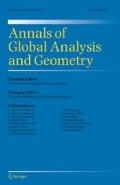As noted by Xuangzhi Cao and Qun Chen the term \(|\hbox {d}\phi _t(e_1)\wedge \hbox {d}\phi _t(e_2)|^2\) was written as \(|\hbox {d}\phi _t|^4\) at several places in [1], which we will correct below.
Regarding [1, Lemma 4.5], the corrected version looks like:
Lemma
Let \(\phi _t:M\times [0,T_{\max })\rightarrow N\) be a smooth solution of (4.1) in [1] and \(V\in C^2(N)\). Assume that \(N\) has negative sectional curvature. Then for all \(t\in [0,T_{\max })\) the following inequalities hold:
$$\begin{aligned} \frac{\partial }{\partial t}\frac{1}{2}|\mathrm{d}\phi _t|^2&\le \Delta \frac{1}{2}|\mathrm{d}\phi _t|^2 +c_1|\mathrm{d}\phi _t|^2+\left( \frac{1}{2}|Z|_{L^\infty }^2-2\kappa _N\right) |\mathrm{d}\phi _t(e_1)\wedge \mathrm{d}\phi _t(e_2)|^2 \end{aligned}$$
(0.1)
and
$$\begin{aligned} \frac{\partial }{\partial t}\frac{1}{2}\left| \frac{\partial \phi _t}{\partial t}\right| ^2&\le \Delta \frac{1}{2}\left| \frac{\partial \phi _t}{\partial t}\right| ^2 +\left( |\nabla Z|_{L^\infty }+\frac{1}{4}|Z|_{L^\infty }^2\right) |\mathrm{d}\phi _t|^2\left| \frac{\partial \phi _t}{\partial t}\right| ^2+c_2\left| \frac{\partial \phi _t}{\partial t}\right| ^2 \end{aligned}$$
(0.2)
with \(c_1:=|\mathrm{Ric}^{\mathrm{M}}|_{L^\infty }+|R|_{L^\infty }|{\text {Hess}}V|_{L^\infty }, c_2:=|R|_{L^\infty }|{\text {Hess}}V|_{L^\infty }\) and the positive number \(\kappa _N\) denotes an upper bound on the absolute value of the sectional curvature of \(N\).
Proof
We have the following Bochner formula (formula (4.3) in [1])
$$\begin{aligned} \frac{\partial }{\partial t}\frac{1}{2}|\hbox {d}\phi _t|^2&=\Delta \frac{1}{2}|\hbox {d}\phi _t|^2 -|\nabla \hbox {d}\phi _t|^2 +\langle R^N(\hbox {d}\phi _t(e_\alpha ),\hbox {d}\phi _t(e_\beta ))\hbox {d}\phi _t(e_\alpha ),\hbox {d}\phi _t(e_\beta )\rangle \\&\quad -\langle \hbox {d}\phi _t(Ric^M(e_\alpha )),\hbox {d}\phi _t(e_\alpha )\rangle +\langle Z(\mathrm{d}\phi _t(e_1)\wedge \mathrm{d}\phi _t(e_2)),\tau (\phi _t)\rangle \nonumber \\&\quad -R{\text {Hess}}V(\hbox {d}\phi _t,\hbox {d}\phi _t). \end{aligned}$$
First, we estimate
$$\begin{aligned} |\langle Z(\mathrm{d}\phi _t(e_1)\wedge \mathrm{d}\phi _t(e_2)),\tau (\phi _t)\rangle |\le \sqrt{2}|Z|_{L^\infty }|\mathrm{d}\phi _t(e_1)\wedge \mathrm{d}\phi _t(e_2)||\nabla \mathrm{d}\phi _t|, \end{aligned}$$
which yields
$$\begin{aligned} \langle Z(\mathrm{d}\phi _t(e_1)\wedge \mathrm{d}\phi _t(e_2)),\tau (\phi _t)\rangle -|\nabla \mathrm{d}\phi _t|^2\le \frac{1}{2}|Z|^2_{L^\infty }|\mathrm{d}\phi _t(e_1)\wedge \mathrm{d}\phi _t(e_2)|^2. \end{aligned}$$
Furthermore, we find (see also [2, Lemma 3.1])
$$\begin{aligned} \left\langle R^N(\hbox {d}\phi _t(e_\alpha ),\hbox {d}\phi _t(e_\beta ))\hbox {d}\phi _t(e_\alpha ),\hbox {d}\phi _t(e_\beta )\right\rangle&= 2\left\langle R^N(\hbox {d}\phi _t(e_1),\hbox {d}\phi _t(e_2))\hbox {d}\phi _t(e_1),\hbox {d}\phi _t(e_2)\right\rangle \\&=2\left\langle Q^N(\hbox {d}\phi _t(e_1)\wedge \hbox {d}\phi _t(e_2)),\hbox {d}\phi _t(e_1)\wedge \hbox {d}\phi _t(e_2)\right\rangle \\&\le -\,2\kappa ^N|\hbox {d}\phi _t(e_1)\wedge \hbox {d}\phi _t(e_2)|^2.\\ \end{aligned}$$
Here, \(Q^N\) denotes the curvature operator on \(N\). By assumption \(N\) is compact and we can estimate the Hessian of the potential \(V(\phi )\) by its maximum yielding the first claim.
Regarding the second statement, we want to mention that the original proof is correct. \(\square \)
Via the maximum principle we thus obtain the following (which is Corollary 4.6 in [1] with adjusted constants).
Corollary
If \(\frac{1}{2}|Z|_{L^\infty }^2\le \kappa ^N\) then for all \(t\in [0,T_{\max })\) the following estimates hold:
$$\begin{aligned} |\mathrm{d}\phi _t|^2&\le |\mathrm{d}\phi _0|^2e^{2c_1t}, \end{aligned}$$
(0.3)
$$\begin{aligned} \left| \frac{\partial \phi _t}{\partial t}\right| ^2&\le \left| \frac{\partial \phi _0}{\partial t}\right| ^2e^{\frac{\left( |\nabla Z|_{L^\infty }+\frac{1}{4}|Z|^2_{L^\infty }\right) |\mathrm{d}\phi _0|^2}{c_1}e^{2c_1t}+c_2t}. \end{aligned}$$
(0.4)
We also correct a typo in the proof of [1, Lemma 4.8]. The equation on lines 5 and 6 on page 358 should be
$$\begin{aligned} \frac{\partial h}{\partial t}&=\Delta h-|\hbox {d}u-\hbox {d}v|^2-\langle \mathrm {I\!I}_u(\hbox {d}u,\hbox {d}u)-\mathrm {I\!I}_v(\hbox {d}v,\hbox {d}v),u-v\rangle \\&\quad -\langle Z_u(\hbox {d}u(e_1)\wedge \hbox {d}u(e_2))-Z_v(\hbox {d}v(e_1)\wedge \hbox {d}v(e_2)),u-v\rangle \\&\quad -R\langle \nabla V(u)-\nabla V(v),u-v\rangle . \end{aligned}$$
We also want to point out that one needs the following statement in the proofs of Lemma 4.15 and Lemma 4.16, which was not explicitly given in [1].
Lemma
Let \(\phi _t:M\times [0,T_{\max })\rightarrow N\) be a smooth solution of (4.1) in [1] with \(V\in C^2(N)\) and \(\nabla Z=0\). Assume that \(N\) has negative sectional curvature. If \(\frac{1}{2}|Z|_{L^\infty }^2\le \kappa ^N\) then for all \(t\in [0,T_{\max })\) the following inequality holds
$$\begin{aligned} \frac{\partial }{\partial t}\frac{1}{2}\left| \frac{\partial \phi _t}{\partial t}\right| ^2&\le \Delta \frac{1}{2}\left| \frac{\partial \phi _t}{\partial t}\right| ^2-\frac{1}{2}\left| \nabla \frac{\partial \phi _t}{\partial t}\right| ^2-R{\text {Hess}}V\left( \frac{\partial \phi _t}{\partial t},\frac{\partial \phi _t}{\partial t}\right) . \end{aligned}$$
(0.5)
Proof
Here, we make use of the following Bochner formula ((4.4) in [1])
$$\begin{aligned} \frac{\partial }{\partial t}\frac{1}{2}\left| \frac{\partial \phi _t}{\partial t}\right| ^2&= \Delta \frac{1}{2}\left| \frac{\partial \phi _t}{\partial t}\right| ^2-\left| \nabla \frac{\partial \phi _t}{\partial t}\right| ^2 +\left\langle R^N\left( \mathrm{d}\phi _t(e_\alpha ),\left( \frac{\partial \phi _t}{\partial t}\right) \mathrm{d}\phi _t(e_\alpha )\right) ,\frac{\partial \phi _t}{\partial t}\right\rangle \nonumber \\&\quad -\left\langle \frac{\nabla }{\partial t}Z(\mathrm{d}\phi _t(e_1)\wedge \mathrm{d}\phi _t(e_2)),\frac{\partial \phi _t}{\partial t}\right\rangle -R{\text {Hess}}V\left( \frac{\partial \phi _t}{\partial t},\frac{\partial \phi _t}{\partial t}\right) . \end{aligned}$$
We calculate
$$\begin{aligned} \frac{\nabla }{\partial t}Z(\mathrm{d}\phi _t(e_1)\wedge \mathrm{d}\phi _t(e_2))&=Z\left( \frac{\nabla }{\partial t}\mathrm{d}\phi _t(e_1)\wedge \mathrm{d}\phi _t(e_2)\right) +Z\left( \mathrm{d}\phi _t(e_1)\wedge \frac{\nabla }{\partial t}\mathrm{d}\phi _t(e_2)\right) , \end{aligned}$$
which allows us to estimate
$$\begin{aligned} \left\langle \frac{\nabla }{\partial t}Z(\mathrm{d}\phi _t(e_1)\wedge \mathrm{d}\phi _t(e_2)),\frac{\partial \phi _t}{\partial t}\right\rangle&\le |Z|_{L^\infty }\left| \frac{\nabla }{\partial t}\mathrm{d}\phi _t\right| \left| \mathrm{d}\phi _t\wedge \frac{\partial \phi _t}{\partial t}\right| ,\\ \left\langle R^N(\mathrm{d}\phi _t(e_\alpha ),\left( \frac{\partial \phi _t}{\partial t}\right) \mathrm{d}\phi _t(e_\alpha ),\frac{\partial \phi _t}{\partial t}\right\rangle&\le -\kappa ^N\left| \mathrm{d}\phi _t\wedge \frac{\partial \phi _t}{\partial t}\right| ^2. \end{aligned}$$
The result follows by applying Young’s inequality. \(\square \)
We also correct several typos in [1, Lemma 4.21]. The inequality given at the bottom should be
$$\begin{aligned} E(\phi _1)-E(\phi _2)&=\int _0^1\hbox {d}\sigma \int _0^\sigma \left( \left| \nabla \frac{\partial \Phi }{\partial s}\right| ^2-\left\langle R^N\left( \hbox {d}\Phi ,\frac{\partial \Phi }{\partial s}\right) \hbox {d}\Phi ,\frac{\partial \Phi }{\partial s}\right\rangle \right. \\&\quad +\left\langle \frac{\partial \Phi }{\partial s},Z\left( \frac{\nabla }{\partial s}\hbox {d}\Phi (e_1)\wedge \hbox {d}\Phi (e_2)\right) \right\rangle \\&\quad \left. +\left\langle \frac{\partial \Phi }{\partial s},Z\left( \hbox {d}\Phi (e_1)\wedge \frac{\nabla }{\partial s}\hbox {d}\Phi (e_2)\right) \right\rangle +R{\text {Hess}}V\left( \frac{\partial \Phi }{\partial s},\frac{\partial \Phi }{\partial s}\right) \right) \hbox {d}s \\&\ge \int _0^1\hbox {d}\sigma \int _0^\sigma \left( \left| \nabla \frac{\partial \Phi }{\partial s}\right| ^2+\kappa _N\left| \hbox {d}\Phi \wedge \frac{\partial \Phi }{\partial s}\right| ^2 -|Z|_{L^\infty }\left| \hbox {d}\Phi \wedge \frac{\partial \Phi }{\partial s}\right| \left| \nabla \frac{\partial \Phi }{\partial s}\right| \right. \\&\left. \quad +R{\text {Hess}}V\left( \frac{\partial \Phi }{\partial s},\frac{\partial \Phi }{\partial s}\right) \right) \hbox {d}s \\&\ge \int _0^1\hbox {d}\sigma \int _0^\sigma \left( \frac{1}{2}\left| \nabla \frac{\partial \Phi }{\partial s}\right| ^2+\left( \kappa ^N-\frac{1}{2}|Z|^2_{L^\infty }\right) \left| \hbox {d}\Phi \wedge \frac{\partial \Phi }{\partial s}\right| ^2 \right. \\&\left. \quad +R{\text {Hess}}V\left( \frac{\partial \Phi }{\partial s},\frac{\partial \Phi }{\partial s}\right) \right) \hbox {d}s \\&>0. \end{aligned}$$

